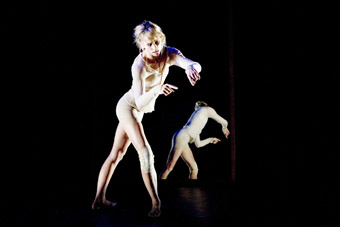across minds and cultures
pauline manley sees kathryn dunn’s into

Kathryn Dunn
photo Prudence Upton
Kathryn Dunn
AS THE AUDIENCE SETTLES AND QUIETENS, THE ORIGINAL OWNERS OF THIS STOLEN LAND ARE ACKNOWLEDGED. THE STAGE IS A BLACK CURTAINED CUBE AND SLOWLY, IN A CRUCIFIX OF LIGHT, AN AMORPHOUS SHAPE BECOMES APPARENT. IT IS A DARK FIGURE, MUTELY LIT. SONOROUS MUSIC PLAYS AS A STARKLY WHITE ARM EMERGES AND DANCES ON ITS OWN, DISEMBODIED AND THIN.
Kathryn Dunn will dance solos from choreographers Frances Rings and Narelle Benjamin. First is Belonging by Rings, which moves from its austere beginning to more expansive movements that softly rock into opening and closure. Dunn’s sinuous wrists turn themselves inside out and she becomes creature-like, fleetingly a lizard, then a bird. But the pointed feet of the ballerina break the shape shifting. Her white skin is luminous in the now grey light and her pert bottom points at us in disclosure of the private body. She swims suspended in thick air, rippling with small muscular movements. She unravels her limbs and folds them in as she dances around her own centre, stroking herself like a loved one. In this intimate room I can hear her move and my innards empathetically dance with her in this intricate and delicate choreography.
Dunn is highly trained in western dance forms and while she is supremely sure footed, she is light more than grounded, more virtuosic than idiosyncratic. Her feet do not the have poetry of an Indigenous dancer. I wondered why she had commissioned an Indigenous choreographer to create a work for her and why an Indigenous chreographer would choose a skinny white woman to dance her dance. Maybe I should tread lightly here, but throughout Belonging it unnerved me to watch this dancer with pointed feet move to David Page’s score in an unmistakably Aboriginal landscape of choreography. Once, and only once, I attempted the dances of Arnhem Land and I knew, in every part of me, that this was not my dance and that maybe this was one of the few things we could not take from them. But after the performance the choreographer smiled broadly as she took her bow, willing and happy.
After an interval too short to drink a glass of wine, we re-entered the cube to a very altered atmosphere. Hung as a fourth wall was a sheer curtain that suspended images in space. Its intrusive thrust into space flung me back in my seat. With a screechingly harsh soundscape Figment developed into an overloaded ride into madness. The sadness of the lone dancer iterates the isolation of insanity and its medical interventions. Layers of reality exist on top of one another in a miasma of sound, vision and movement. The contorted motions of Dunn are swamped by the matrix of production elements, like the schizophrenic drowning under the weight of a noisy and harsh world. Narelle Benjamin bravely and honestly tells the story of her sister and this truth left me completely smashed. The violence of schizophrenia and a sibling’s intense sadness had been imparted.
Into, performer Kathryn Dunn, Belonging, choreography Francis Rings, composer David Page, costume/design Jacob Nash; Figment, choreography Narelle Benjamin, composer Huey Benjamin, video/design Sam James, lighting Glenn Hughes; Riverside Theatres, Parramatta, Jan 8-12, The Studio, Sydney Opera House, Jan 15–20
RealTime issue #83 Feb-March 2008 pg. 13






